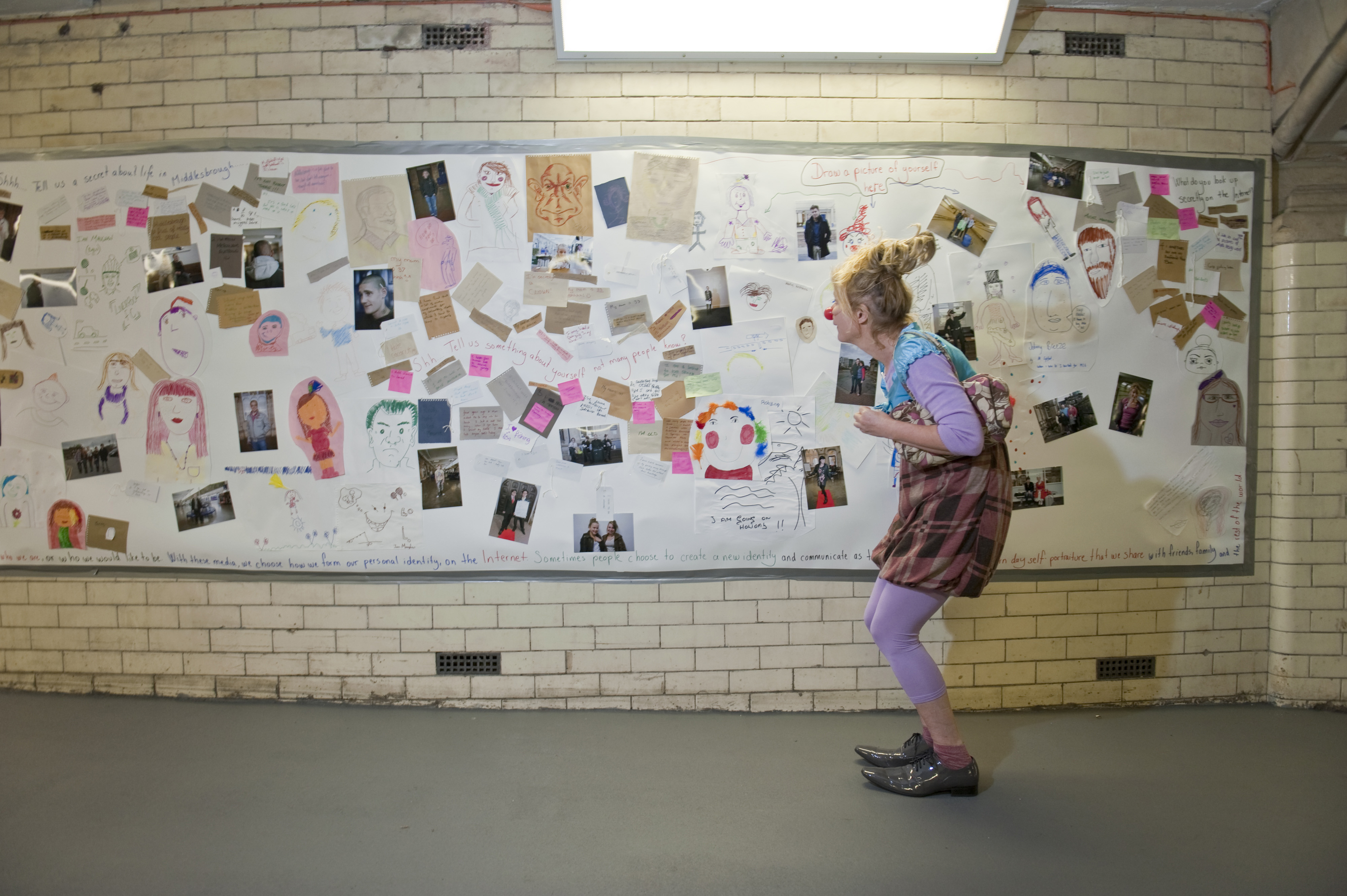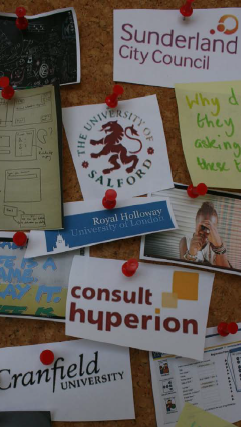Collage in Middlesbrough: VOME and the Festival of Social Science 2011 (Written by Freya Stang)
On a cold weekend in October 2011 as part of the VOME (Visualisation and Other Methods of Expression) team, headed by Dr Lizzie Coles Kemp, I set off for the Middlesbrough Railway station in North Yorkshire. I was off to take part in the hosting of an event called Privacy.Co.Ok? Part of the Economic & Social Research Council’s Festival of Social Science; a weeklong series of events celebrating the breadth of research being undertaken in the UK. The VOME team wanted to create an event for the Festival that would stimulate thought on the topic of on-line communication, expression and privacy. We also wanted to reach as wide a variety of people as possible and to engage those who would not normally become involved with academic research activities.
Our chosen venue, Middlesbrough Railway Station, was perfect for this, as it is a space of movement and transfer. People of all ages, different ethnic groups and social backgrounds come and go from this location; connecting, meeting and parting. It’s a public space where intimate moments happen. It’s also a place where people spend time watching other people, much like the way people often behave on the Internet.
We wanted to engage with the people of Middlesbrough in an artistic co-creation of a visual sound collage, using the topic of On-Line Privacy. We wanted to build on the themes identified during the Privacy Workshop for Artists, London, March 2011. This time though, instead of working with a group of artists, we wanted to engage with the general public.
In Middlesbrough our starting point was an enormous blank canvas set up in the station platform underpass. We were hoping that by the end of the weekend this would be filled with self portraits and portraits of people at the station. We also hoped that the canvas would capture some of their thoughts about themselves, comments on their secret on-line activities and on life in Middlesbrough.
To draw the public in and to help stimulate thought and creativity, a small team of performers used themed character interactions. Reeta, one of the performers, had a suitcase of her own secrets that she shared. Andy Christie and Jose Parra (Bimbilibausa) went out in duo, acting as live comment boards, changing identity with use of masks and providing light relief by way of celebrity red-carpet interactions which led to portrait taking, skillfully photographed by Luke Avery. We showed a short humorous (5 min) film made specifically for this year’s FSS event by Rita and myself, starring Rita, called ‘Watching or Being Watched’. It could be viewed through a keyhole installation in the station’s café. Rita interacted with people as this character and also went out as another masked character. I went out as Margareth the clown, bearing the world’s smallest mask, the red nose. The red nose is the mask of the theatrical clown and it reveals aspects of the often hidden self; it displays humanity and therefore often touches people.
Mask work is an interesting artistic practice in relation to the process of how people choose to present themselves when they are on the internet. Mask work involves dealing with issues and questions about how we construct a sense of identity, who we wish to be and how we want to be seen by others. The Character interactions worked well, engaging people with the event and allowing them to begin to discuss the themes with the characters. Through this process they started to make links with our theme; telling stories about their own personal history and how they are affected through their participation on the internet.
On the main station concourse we displayed portraits painted by the visual artist, Rika Deyrike, at the Privacy Workshop for Artists. We also played sound recordings by Viv Corringham (PWA). Screenings of Bimbilibausa Theatre’s clown theatre piece OnandOff Line, created for VOME and the Festival of Social Science 2010, took place in the waiting room.
As the weekend progressed, teenagers, pensioners, parents with their children, professionals, visitors and some homeless people interacted with the VOME team. Many of these people became engaged with our theme, developing it while expressing themselves and sharing their expression publically. The collage in the platform underpass started to take form and was filled with images and comments.
By contributing to the collage in Middlesbrough people were sharing parts of their identity and history with others, in a very public place. Some of this would be revealing for the individual, some of this would be sheltered under the wing of anonymity in the wholeness. We did of course seek permission for usage from each individual person who contributed. Their individual contributions of self portraits, portraits and comments started to become a part of a collective whole.
We had chosen to seek their expression through using the medium of a collectively produced collage because this medium carries such strong links to the way people use the internet. The nature of the internet means that we don’t have full control of what actually happens to our images; we are a part of the collective whole where images and information can be changed by others, used and added to.
The Internet and modern electronic devices allow more people greater opportunity for self-expression than in past times, in fact shared self-expression for many has now become the norm. Artists have for centuries formed self-portraits to display themselves personally as well as professionally. Now we can all share images of ourselves with a wider audience and show parts of our life story, and choose how we wish our stories to be seen. With Facebook, blogs and personal webpages we have the opportunity to express, communicate, tell the world who we are, or who we would like to be. With these media, we can choose how we form our personal identity on the internet. We form a modern day self-portraiture that we share with friends, family and the rest of the world.
In the second day of our stay in Middlesbrough, people started gathering in the station underpass to see the contributions made on the collage. Those contributing had through the photographs and selfportraits generously shared images of themselves. They had also within the collective whole self disclosed and shared information that was personal to them; this also included what they secretly look up on the net. The collage was starting to take on a life of its own, becoming something that belonged to the space. With a feeling of regret we took it down on the Sunday afternoon, our time there coming to an end. It felt as if we’d witnessed the beginning of something truly exciting that had started to snowball. We then took a fond farewell from Middlesbrough, the people there and the proud historic station building that has carried its own secrets in other times.


